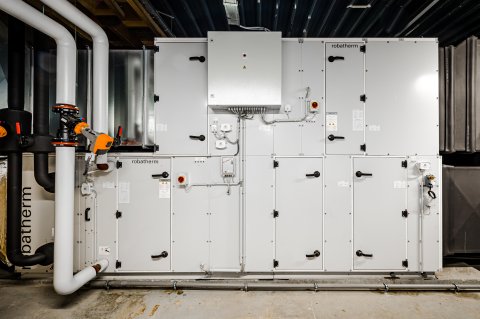Vad är Computer-Aided Facility Management?
Programvara för Computer-Aided Facility Management (Datorstödd Facility Management, CAFM) hjälper ansvariga att planera, utföra och övervaka alla aktiviteter som ingår i utrymmes- och arbetsplatshantering, tillgångshantering, reaktivt och planerat förebyggande underhåll, operationella anläggningstjänster, rumsbokningar och övrig kundtjänst.
Det råder ofta förvirring mellan CMMS- och CAFM-programvara, även om de tjänar mycket olika syften. CMMS-programvara (Computerized Maintenance Management System) är främst inriktad på förebyggande och korrigerande underhåll av teknisk utrustning. CAFM-programvara täcker däremot ett bredare funktionsområde: lokalhantering, användartjänster, arbetsmiljö och användarnas välbefinnande.
Kort sagt gör informationen från CAFM-programvarulösningarna att cheferna kan förbättra den långsiktiga planeringen av utrymmen, lokaler, underhåll, tjänster och budgetar i enlighet med kärnverksamhetens behov. Om du är intresserad av att lära dig mer om Planons CAFM-programvarulösning är du välkommen att kontakta oss för att boka en demo.
CAFM och CAD
En bild säger mer än tusen ord. Därför integrerar CAFM-programvaran CAD-ritningar i olika processer såsom utrymmeshantering, scenarioplanering, planlösningar, flexibla arbetsplatser, flyttar och teknisk hantering.
Branschstandarder
För att säkerställa effektiv återanvändning av CAD-ritningar med CAFM-programvara måste ritningarna följa konventioner för lagerstrukturer, polylines, symboler, block, text, dimensionering osv. De kan följa antingen företagets standarder eller standarder som fastställs av organ såsom ISO, CEN eller IFMA.
Genom att efterleva dessa konventioner kan du förenkla processen med att koppla CAD-ritningar till din CAFM-lösning och konsekvent utbyta relevanta data om exempelvis utrymmen, dimensioner och tillgångar.
Grafiska och alfanumeriska ändringar
CAD-ritningar är bara användbara i CAFM-system om de hålls aktuella. Att uppdatera CAD-ritningar är vanligtvis ett specialiserat jobb i AutoCAD® som innebär flytt av väggar, sammanslagning av utrymmen och omfördelning av tillgångar eller avdelningar. Dessa ändringar kan visserligen göras snabbt och enkelt i en CAD-ritning, men du måste även se till att den nya informationen uppdateras i CAFM-databasen.
CAFM-programvara hanterar sådana datautbytesprocesser på olika sätt, antingen genom att regelbundet importera reviderade ritningar eller genom att uppdatera databasinformationen i realtid. Det säkerställer en konsekvent koppling och tillförlitlig integrering mellan CAFM och CAD.
Scenarioplanering
En viktig fördel med CAD-program som AutoCAD®är möjligheten att skapa olika scenarier för processer som utrymmesplanering, flytthantering och tillgångshantering. När du kombinerar dessa scenarier med en CAFM-lösning kan du rapportera, jämföra och analysera scenarier för att göra det bästa valet.
När ett scenario har valts kommer CAFM-systemet automatiskt att uppdatera din databas och stödja processerna med projektledning, arbetsplatshantering, arbetsorderkontroll och budgethantering.
Genom att kombinera CAFM med CAD kan du enkelt visualisera databasinformationen i realtid (inklusive utrymmesanvändning, lediga platser och nödutrymningsvägar) med färgkodade mappningar. Den grafiska visualiseringen besvarar frågor om ”var”, t.ex. var avdelningarna ligger, var tillgångarna finns och var det finns ledigt utrymme.
Moderna CAFM-lösningar inkluderar visningsprogram som gör att en bredare målgrupp kan söka i CAD-ritningar, utan någon särskild CAD-programvara. Appar på mobiltelefoner kan också användas för att enkelt söka bland grafisk information för att hitta lediga platser och arbetsplatser eller för att helt enkelt hitta en kollega.
CAFM, IWMS eller CPIP – stora skillnader eller bara hajp?
CAD software har genomgått stora förändringar både vad gäller funktionalitet och teknik. En viktig förändring är integreringen av olika processer inom anläggningsförvaltning (FM) och fastighetsförvaltning (CRE) i en enda lösning. Många organisationer använder fortfarande punktlösningar eller egna verktyg för specifika processer, men det finns en tydlig trend mot mer integrerade lösningar.
Flera programvaruleverantörer kallar sina CAFM-system för IWMS (Integrated Workplace Management System, integrerat arbetsplatshanteringssystem) eller CPIP (Connected Portfolio Intelligence Platforms, anslutna intelligenta portföljsystem), men vad är det egentligen för skillnad när det gäller funktionalitet, teknik och mervärde för ditt företag?
Ursprungligen utformades CAFM-system för att hantera specifika Facility Management-uppgifter såsom utrymmesplanering, tillgångsspårning och underhållshantering. Dessa tidiga system fokuserade på att tillhandahålla verktyg för att registrera och visualisera data, oftast med hjälp av CAD för utrymmeshantering. I slutet av 1990-talet och början av 2000-talet, då organisationer sökte större effektivitet och omfattande insikter inom flera verksamhetsområden, började CAFM-systemen införliva ytterligare funktionalitet till stöd för utökade affärsprocesser. Organisationer ville ha en enhetlig lösning som kunde integrera fastighetsförvaltning, underhåll och kapitalprojektledning snarare än att förlita sig på separata system.
År 2004 introducerade Gartner termen Integrated Workplace Management System, IWMS, för att återspegla en helt ny generation av enhetliga programvarulösningar. Ett IWMS definierades som en programvaruplattform i företagsklass som integrerade nyckelfunktioner från fem viktiga domäner i en gemensam teknikplattform med ett centraliserat datalager. Dessa fem domäner var:
- Real Estate Management: Hanterar förvärv, ägarskap och avyttring av fastighetstillgångar, inklusive leasingadministration och leasingredovisning.
- Facilities & Space Management: Övervakar drift och underhåll av byggnader och infrastruktur, inklusive planering, allokering och användning av utrymmen.
- Asset & Maintenance Management: Spårar och hanterar fysiska tillgångar, schemalägger underhåll och optimerar tillgångarnas livscykler.
- Capital Project Management: Planerar, genomför och övervakar kapitalprojekt såsom konstruktion, renovering och utbyggnad.
- Environmental Sustainability: Främjar miljövänliga metoder, minskar miljöpåverkan och säkerställer efterlevnad av hållbarhetsregler.
Ett IWMS skiljer sig alltså avsevärt från ett CAFM då det har ett mycket bredare utbud av funktioner och möjligheter. Men som Gartner påpekar är kanske den viktigaste skillnaden att äkta IWMS-lösningar är baserade på en gemensam teknikplattform och ett datalager. Detta särskiljer den från en samling enskilda lösningar.
I slutet av 2010-talet dök anslutna, intelligenta portföljplattformar (Connected Portfolio Intelligence Platform, CPIP) upp som ett led i utvecklingen av CAFM/IWMS. CPIP-lösningar ger ökat kundvärde genom insikter som härrör från sakernas internet (IoT) och mer avancerade analysverktyg. De integrerar datainsamling i realtid och avancerade funktioner, såsom prediktiv analys och AI, som erbjuder mer uppkopplad och intelligent kapacitet.
Ta reda på mer om IWMS och CPIP och se om någon av lösningarna uppfyller dina behov.
Jämförelse av CAFM, CMMS, IWMS och CPIP
Undrar du fortfarande vad de viktigaste skillnaderna är mellan CAFM, CMMS, IWMS och CPIP? Tabellen nedan visar de viktigaste för- och nackdelarna med varje lösning.
| System |
Fokus |
Fördelar |
Nackdelar |
| CAFM |
Utrymmeshantering, schemaläggning av underhåll, spårning av tillgångar och resursfördelning |
Kostnadseffektivt för mindre organisationer, snabbare implementering, anpassningsmöjligheter |
Begränsad funktionalitet och skalbarhet, mer driftfokuserad, mindre strategisk |
| IWMS |
Utrymmeshantering, underhållshantering, hantering av tillgångars livscykler, integrerade tjänster, energi- och hållbarhetshantering, fastighetsförvaltning |
Integrerar och centraliserar data från olika källor, avdelningar och system i realtid, skalbarhet. Konfigurerbarhet, integrerar strategiska insikter i verksamheten |
Kan ta längre tid att implementera, omfattande funktionsuppsättning kan vara övermäktig för organisationer med begränsade krav |
| CMMS |
Underhållsarbete och underhåll av utrustning |
Effektiviserar underhållsprocesser, tillgång till data av hög kvalitet för beslutsfattande |
Kan ta längre tid att implementera, kan kräva ny processimplementering |
| CPIP |
Dataintegrering i realtid, avancerad analys, IoT-baserade insikter och smart fastighetsförvaltning |
Ger ökat kundvärde genom IoT och analysverktyg, stöder smartare arbetsflöden och ökad automatisering, modulär och molnbaserad för enkel integrering med appar från tredje part |
Kan kräva betydande investeringar i IoT-infrastruktur, komplex hantering och integrering av olika datakällor, potentiellt behov av specialiserad kompetens för användning av avancerade analysverktyg |
I grund och botten är ett IWMS ett företagssystem som är utformat för att stödja en större uppsättning funktioner för stora, komplexa organisationer. CAFM har däremot ett smalare fokus för att hantera anläggningar och deras fysiska utrymmen, och riktar sig främst till medelstora och små företag. Ett CMMS stöder underhållsarbete och underhåll av utrustning. CPIP-system omfattar alla dessa funktioner men kräver mer tid för fullständig integrering.
Framtiden för fastighetsförvaltning med CAFM, IoT och AI
Genom en kombination av datorstödd Facility Management (CAFM), sakernas internet (IoT) och artificiell intelligens (AI) förvandlas konventionella byggnader till smarta, effektiva miljöer. Denna integration förbättrar aktiviteter inom Facility Management avsevärt genom ökad effektivitet, hållbarhet och kostnadseffektivitet.
Ökad hållbarhet och minskade kostnader
- Energioptimering: Realtidsdata från IoT-enheter och AI-driven analys möjliggör exakt kontroll av energisystem. Detta minskar avfallet och hjälper byggnader att uppfylla miljöstandarder och rapporteringskrav avseende ESG och nettonollmål.
- Verksamhetseffektivitet: Automatisering av rutinuppgifter med hjälp av CAFM- och IoT-teknik minskar arbetskostnaderna. Uppgifter som datainsamling, schemaläggning av underhåll och uppdatering av utrymmesanvändning hanteras automatiskt, vilket gör att personalen kan fokusera på viktigare aspekter.
- Kostnadshantering: Genom att analysera data om utrymmesanvändning kan anläggningschefer bättre förstå hur utrymmena används. Denna insikt möjliggör optimering av de utrymmen som används och de som inte används tillräckligt, vilket har en betydande inverkan på intäkterna eftersom många kontorsutrymmen som knappt används kan medföra omotiverade kostnader genom onödig kylning, uppvärmning och belysning.
Proaktivt underhåll och strategiska insikter
- Förebyggande underhåll: AI kan analysera data från IoT-enheter för att förutsäga när utrustning kan gå sönder, vilket möjliggör underhåll i rätt tid. Detta proaktiva tillvägagångssätt minskar stilleståndstiden med upp till 50% och förlänger utrustningens livslängd med upp till 40%.
- Datadrivet beslutsfattande: AI ger värdefulla insikter och påtalar aktuella trender som är i utveckling eller ännu inte har identifierats och som kan hjälpa anläggningschefer att fatta välgrundade beslut om resurshantering och kontinuerligt förbättra anläggningsdriften.
Att bestämma vad som passar bäst
Funderar du på vilken lösning som bäst uppfyller organisationens behov? Kontakta oss då för en personlig demo för att se hur Planon kan hjälpa dina anläggningsteam att uppfylla fastighetsbehoven, både idag och imorgon.
Fallstudier
En av Planons kunder, University of Sunderland, upptäckte att deras gamla CAFM-system inte längre höll jämna steg med behoven och förväntningarna, så de bestämde sig för att istället hitta ett IWMS för att förbättra verksamheten och rapporteringen för flera avdelningar. Deras driftsättning med Planon skedde på 7 veckor.
Vanliga frågor
Förutom anläggningschefer används CAFM-programvaran också av fastighetsexperter och underhållsteam för att effektivisera anläggningars driftprocesser och förbättra hanteringen av tillgångs-, underhålls- och utrymmesregister. CAFM-lösningar ger dessa användare en heltäckande översikt över all anläggningsverksamhet.
Information från CAFM-lösningar hjälper organisationer att hantera sina byggnader och anläggningar mer effektivt. Så här kan CAFM-programvaran användas av yrkesverksamma:
Anläggningschefer
- Utrymmeshantering. CAFM-system hjälper till att optimera utrymmesanvändningen genom att ge detaljerade insikter om hur utrymmena används, identifiera områden som inte används tillräckligt och stödja identifiering av omkonfigurationsinsikter för att maximera effektiviteten.
- Tillgångshantering. De kan hålla reda på alla anläggningstillgångar, se till att de underhålls och används på rätt sätt och minska risken för förlust eller felplacering.
Fastighetschefer
- Hantering av leasingavtal. CAFM kan hantera leasingavtal, hålla reda på när leasingavtal löper ut och säkerställa efterlevnad av leasingvillkor så att inget förbises och leder till dyra utgifter.
- Portföljanalys. Dessa system erbjuder omfattande dataanalysverktyg som hjälper chefer att utvärdera prestandan hos fastighetstillgångar, fatta välgrundade investeringsbeslut och identifiera möjliga kostnadsbesparingar.
Underhållschefer
- Förebyggande underhåll. CAFM-system kan schemalägga regelbundna underhållsuppgifter, vilket säkerställer att all utrustning servas i tid och minskar sannolikheten för oväntade haverier eller bristande regelefterlevnad.
- Arbetsorderhantering. Effektiviserade processer för att skapa, tilldela och spåra arbetsordrar, vilket säkerställer att underhållsproblem åtgärdas snabbt och effektivt.
Yrkesmässig användning av CAFM-lösningar kan omfatta följande:
- Utrymmeshantering: Använd CAFM för att effektivt organisera planritningar och utrymmesallokering, så att utrymmesanvändningen inom anläggningar kan optimeras.
- Underhållshantering: Använd CAFM för att schemalägga och spåra reparationer och inspektioner systematiskt, vilket säkerställer snabbt underhåll av anläggningar och utrustning.
- Tillgångshantering: Använd CAFM för inventering och övervakning av utrustning och tillgångar, vilket möjliggör effektiva metoder för tillgångshantering.
- Resursplanering: Använd CAFM för att boka rum, utrustning eller tjänster, effektivisera processerna för resursplanering och undvika dubbelbokning.
- Rapportering och analysverktyg: Utnyttja CAFM:s rapporterings- och analysfunktioner för att generera insikter och spåra prestandamått, vilket bidrar till datadrivet beslutsfattande och kontinuerlig förbättring.
- Integrationer: Integrera CAFM med andra system, t.ex. byggnadsautomatisering eller finansiell programvara, vilket möjliggör ett smidigt datautbyte och förbättrar den övergripande verksamhetseffektiviteten.
Få tillgång till anläggningsdata på språng med hjälp av CAFM:s mobila tillgänglighetsfunktioner som hjälper personalen att hantera anläggningar på distans och hålla sig informerade även när de inte är på kontoret.
Programvara för datorstödd Facility Management (Computer Aided Facility Management, CAFM) erbjuder en rad fördelar för anläggningschefer så att de effektivt kan planera, utföra och övervaka olika aktiviteter relaterade till utrymmes- och arbetsplatshantering, tillgångshantering, underhåll, operativa tjänster, rumsbokningar och kundtjänst. Nedan följer några av de främsta fördelarna.
- CAFM-system effektiviserar den operativa övervakningen av anläggningstjänster som städning, säkerhet och catering, vilket säkerställer en smidig leverans av tjänster.
- De automatiserar rutinmässiga datahanteringsuppgifter så att personalen kan fokusera på mer strategiska aktiviteter.
- CAFM-system erbjuder omfattande verktyg för inventering och övervakning av tillgångar, vilket möjliggör effektiva metoder för tillgångshantering.
- De ger insikter om tillgångsanvändning, underhållskrav och livscykelhantering, så att tillgångarnas prestanda och livslängd kan optimeras.
- CAFM möjliggör rumsbokningar och resursplanering så att det blir enkelt att boka rum, utrustning eller tjänster och dubbelbokning undviks.
- CAFM-system erbjuder robusta rapporterings- och analysfunktioner som ger värdefulla insikter om anläggningens prestanda, användningstrender och resursfördelning.
- De stöder ett datadrivet beslutsfattande, vilket gör att chefer lätt kan se var förbättringar krävs och införa strategiska förändringar på ett effektivt sätt.
- CAFM möjliggör effektiv planering och användning av utrymmen samt optimala planlösningar som maximerar effektivitet och produktivitet.
- Det gör övervakning och hantering av arbetsmiljöer enkelt, och säkerställer att de uppfyller personalens behov.
- Med CAFM kan underhållsuppgifter planeras och schemaläggas i förväg, vilket minskar stilleståndstiden och minimerar risken för oväntade utrustningsfel.
- Det gör att förebyggande underhållsprogram kan planeras i förväg, vilket förlänger tillgångarnas livslängd och minskar reparationskostnaderna.
- CAFM möjliggör effektiv kundtjänsthantering som löser ärenden snabbt och ökar den övergripande kundnöjdheten.
- Det ger transparens och uppmuntrar till ansvarskänsla vid hantering av kundförfrågningar och problem.
Our global success stories








